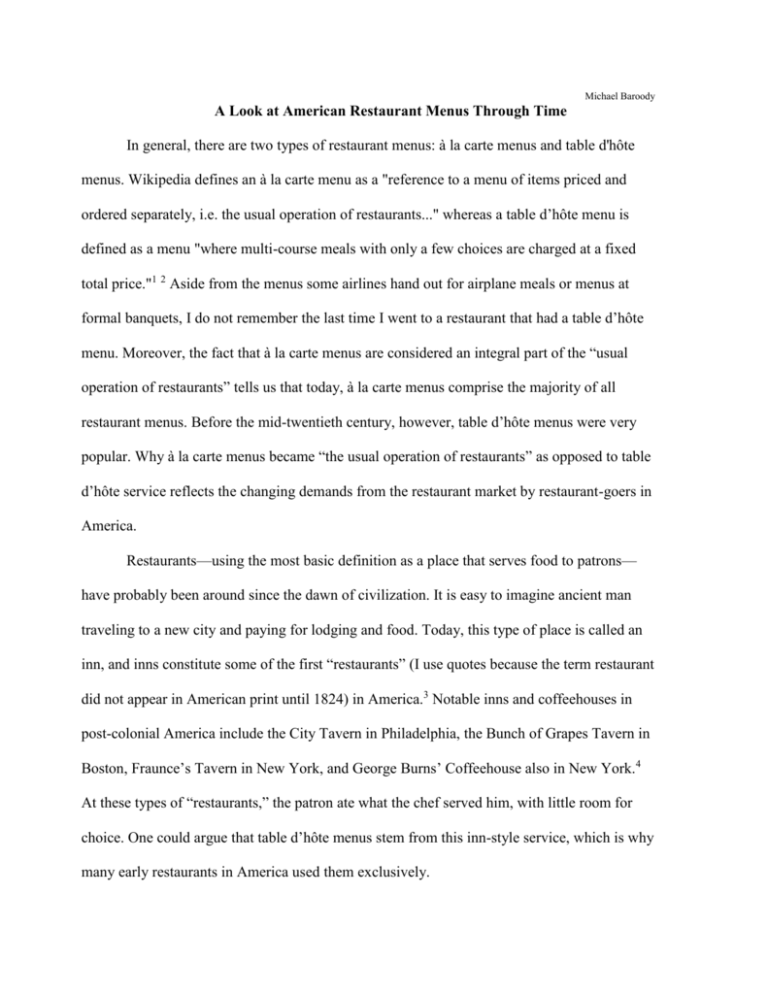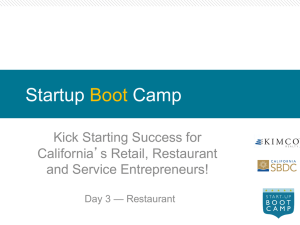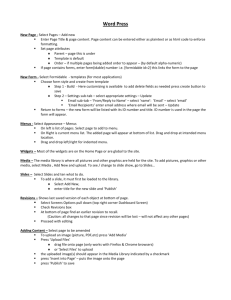Restaurant Menus
advertisement

Michael Baroody A Look at American Restaurant Menus Through Time In general, there are two types of restaurant menus: à la carte menus and table d'hôte menus. Wikipedia defines an à la carte menu as a "reference to a menu of items priced and ordered separately, i.e. the usual operation of restaurants..." whereas a table d’hôte menu is defined as a menu "where multi-course meals with only a few choices are charged at a fixed total price."1 2 Aside from the menus some airlines hand out for airplane meals or menus at formal banquets, I do not remember the last time I went to a restaurant that had a table d’hôte menu. Moreover, the fact that à la carte menus are considered an integral part of the “usual operation of restaurants” tells us that today, à la carte menus comprise the majority of all restaurant menus. Before the mid-twentieth century, however, table d’hôte menus were very popular. Why à la carte menus became “the usual operation of restaurants” as opposed to table d’hôte service reflects the changing demands from the restaurant market by restaurant-goers in America. Restaurants—using the most basic definition as a place that serves food to patrons— have probably been around since the dawn of civilization. It is easy to imagine ancient man traveling to a new city and paying for lodging and food. Today, this type of place is called an inn, and inns constitute some of the first “restaurants” (I use quotes because the term restaurant did not appear in American print until 1824) in America.3 Notable inns and coffeehouses in post-colonial America include the City Tavern in Philadelphia, the Bunch of Grapes Tavern in Boston, Fraunce’s Tavern in New York, and George Burns’ Coffeehouse also in New York.4 At these types of “restaurants,” the patron ate what the chef served him, with little room for choice. One could argue that table d’hôte menus stem from this inn-style service, which is why many early restaurants in America used them exclusively. In the 1850s, many restaurants in America used table d’hôte menus that were changed everyday according to the chef. On October 10, 1856, for example, the Troy House served an eight-course dinner consisting of “Soup,” “Fish,” “Boiled,” “Roast,” “Entrees,” “Vegetables,” “Pastry,” and “Dessert” courses. Most courses had multiple dishes for the customer to choose from, but the whole dinner was sold at a fixed price, and thus customers could not pick and choose dishes.5 At this time, even breakfasts were served table d’hôte-style, although the breakfast menus probably did not change everyday like their dinner menu counterparts. In 1859, the Metropolitan Hotel in New York City was serving a seven-course breakfast that consisted of “Cold,” “Broiled,” “Fried,” “Stewed,” “Eggs,” “Potatoes,” and “Bread” multichoice courses. This breakfast also came with the costumer’s choice of “Tea,” “Coffee,” or “Chocolate.”6 In this time period, restaurant-goers paid for individual meals as opposed to individual items on a menu. In other words, they ate what the chef wanted them to eat. Fast-forward about fifty years and many restaurant menus are still using the table d’hôte format, although some restaurants have begun to adopt the à la carte-style menu as well. In 1907, the Mills Hotel in New York City had both styles for the costumer to choose from. At the top of the menu, the Mills listed all their dishes with the prices alongside. The second half of the menu was entitled “Regular Dinner,” and it was sold at a fixed-price (thirty cents) and included four courses with many choices for each course.7 Although many restaurants still utilized table d’hôte-style menus exclusively, and some used à la carte-style menus exclusively, the Mills Hotel’s menu is an important one because it highlights a transitory period in the demands of American restaurant-goers from fixed-price meals to the ability to pick and choose what they wanted to eat and pay for. The option to purchase a fixed-price meal was popular throughout the twentieth century, but restaurant owners recognized the importance of letting the costumer choose for himself whether he wanted an entire meal or just a specific dish. In 1969, the Edwardian Room in the Plaza Hotel in New York City followed this ideal. At the top of its menu, the Edwardian listed the choices for the first, second, and third courses, should the costumer have chosen the “Complete Luncheon” option as opposed to the “à la Carte” one. These options and their respective prices are listed alongside each entrée.8 Thus each entrée determined the price of the complete meal. Technically this was no longer a fixed-price meal, but one can certainly still consider it table d’hôte-style menu. This style of pricing occurred as early as the 1940s as well.9 By the 1980s, virtually every menu was à la carte-style and table d’hôte-style menus were reserved for banquets and other formal events. At this point, and maybe even before, entrees actually became full meals. The chicken entrée at The Charleston Garden, for example, is “served with rice and a vegetable.” At the same time, though, there was a “Complete Luncheon Special: served with a salad, beverage, and dessert,” as if The Charleston was trying to simulate a course-based meal.10 Restaurants by this time period were catering to every possible customer. Even entrees, now technically full meals, could be modified according to the customer’s needs. Table d’hôte-style service was a thing of the past, but many restaurants began replacing multi-course dishes with large dishes. In a way, these large dishes became fixed-price meals. Today, not much has changed. Most menus are à la carte and the customer can have virtually whatever he wants. Why this happened can be summarized in a comment a user left regarding a special fixed-price holiday menu: Jeff: …BOYCOTT ANY RESTAURANT that tries to force you to use a prix fixe menu, whether it’s Valentine’s Day, New Year’s Eve or any other time. We as customers have to exercise our rights for CHOICE and VARIETY and NOT pay overinflated prices for fewer options. That is idiotic and quite frankly a rip-off. I am offended when a restaurant suddenly thinks that I want to do “prix fixe” just because it happens to be a holiday… $40 or $50 a plate and YOU tell me my options for dinner?…11 On the same post, though, were comments such as this one: Julie: I love it. It makes us try new different things. Also, sometimes my brain is so fried that its nice not to think/choose items. 12 It seems that even today some people still enjoy table d’hôte-style menus, but consumers like Jeff above clearly dominate the restaurant market’s customer base. The transition from table d’hôte menus being the norm to à la carte menus being the norm has been a gradual one that started in the nineteenth century and was completed in the twentieth century. This transition was fueled by restaurant goers like Jeff above who refused to be told what to eat when choosing to pay for food. While it was the smart move on the part of restaurants in America to give the power of choice to their customers, there was definitely something lost when à la carte menus became the norm. When I go to a restaurant (excluding fast food and convenience restaurants), I look for what the chef is trying to accomplish through his food; what dishes he wants his customers to enjoy. That is why I always get the chef’s special if it is available. After all, the chef of a restaurant has made deliberate choices for every single one of his dishes, and this should be respected. Moreover, when table d’hôte menus were the norm, the costumer, in a sense, had a more intimate experience with the chef because he was eating exactly what the chef wanted him to eat. Ultimately, if a customer insists on having what he wants without being open minded about new foods and the intentions of the chef, then why not stay at home and eat? 1 "À la carte." <http://en.wikipedia.org/wiki/À_la_carte>. 2 "Table d'hôte." <http://en.wikipedia.org/wiki/Table_d'hôte>. 3 Mariani, John. "America's Great Historic Restaurants."Forbes. 24 Nov 2010: n. page. Web. 27 Mar. 2013. <http://www.forbes.com/2010/11/23/american-historic-restaurantslifestyle-travel-food-dining.html>. 4 Patterson, C. A. 30 years of progress in American hospitality: A historical sketch of the National Restaurant Association. Chicago: American Restaurant Magazine, 1949. Print. 5 Bill of Fare. Troy, NY: Troy House, 1856. Web. <http://menus.nypl.org/menu_pages/32091>. 6 Breakfast Bill of Fare. New York, NY: Metropolitan Hotel, 1859. Web. <http://menus.nypl.org/menu_pages/29481>. 7 Mills Hotel. New York, NY: Mills Hotel, 1907. Web. <http://menus.nypl.org/menu_pages/31627>. 8 Luncheon. New York, NY: The Plaza Hotel: Edwardian Room, 1969. Web. <http://menus.nypl.org/menu_pages/49930>. 9 Dinner. New York, NY: Chez Marie Restaurant, 1948. Print. 10 Menu. The Charleston Garden, 1989. Web. <http://menus.nypl.org/menus/29239>. 11 Turnkett, Jenny. "Exploring the issue of holiday prix fixe menus." . Access Atlanta, 10 Feb 2011. Web. 27 Mar 2013. <http://blogs.ajc.com/food-and-more/2011/02/10/exploringthe-issue-of-holiday-prix-fixe-menus/?cxntfid=blogs_food_and_more>. 12 See footnote 11.





